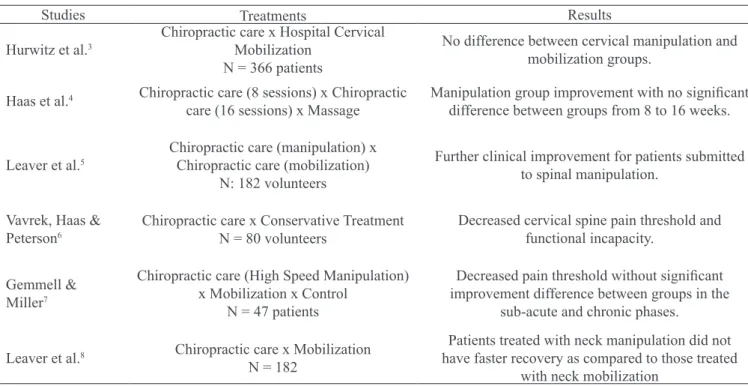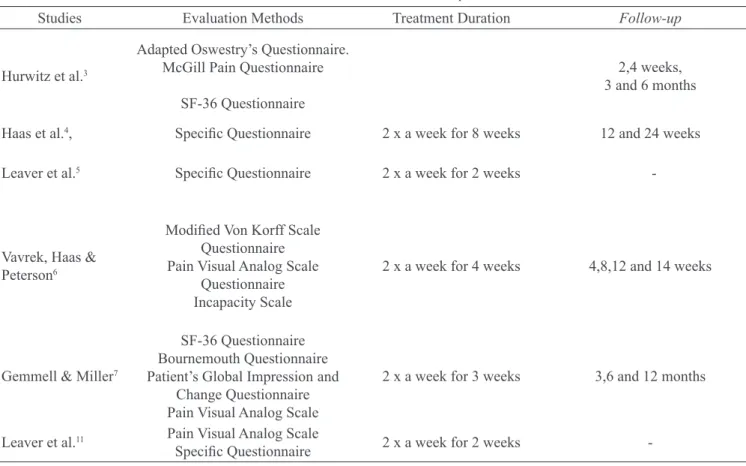71
REVIEW ARTICLESociedade Brasileira para o Estudo da Dor
c
Rev Dor. São Paulo, 2012 jan-mar;13(1):71-4
SUMMARY
BACKGROUND AND OBJECTIVES: Cervical
pain is mostly caused by mechanical-postural changes. Among different therapeutic techniques used by physi-cal therapists, chiropractic care is becoming common in Brazil. This study aimed at reviewing the literature, with secondary and tertiary sources, using Pubmed, Medline and PEdro databases.
CONTENTS: Just 6 controlled randomized clinical
trials investigating the effects of chiropractic care on cervical pain were found. In most studies, manipula-tion techniques have promoted pain relief in a faster and more prolonged way and pain was evaluated by Oswe-stry’s Functional Index, by McGill Pain Questionnaire and by Pain Visual Analog Scale.
CONCLUSION: A larger number of controlled
ran-domized clinical trials involving chiropractic care is needed, as well as the use of more dependable evalua-tion methods, to prove its real effects in the treatment of cervical pain.
Keywords:Cervical pain, Chiropractic care, Controlled randomized clinical trial, Orthopedic manipulation, Physical therapy modalities.
Effects of chiropractic care in patients with cervical pain: a
syste-matic review*
Efeitos da quiropraxia em pacientes com cervicalgia: revisão sistemática
Rodrigo Marcel Valentim da Silva
1, Márcio Souza de Lima
2, Fernando Henrique Costa
2, Ana Carolina
da Silva
3* Received from the Federal University of Rio Grande do Norte. Natal, RN.
1. Graduated in Physical Therapy, Potiguar University (UnP). Master Student in Physical Therapy, Federal University of Rio Grande do Norte (UFRN). Natal, RN, Brazil.
2. Graduated in Physical Therapy, Potiguar University, Natal/ RN. Specialist in Clinical and Sports Chiropractic Care, Inte-grated Universities of Patos. Natal, RN, Brazil.
3. Graduated in Physical Education, Potiguar University (UnP). Natal, RN, Brazil.
Correspondence to:
Rodrigo Marcel Valentim da Silva
Rua Major Newton Leite 151ª – Cidade Alta 59025-180 Natal, RN.
Phone: (84) 9164-5644
E-mail: marcelvalentim@hotmail.com
RESUMO
JUSTIFICATIVA E OBJETIVOS: A dor
cervi-cal é ocasionada na maioria das vezes por alterações mecânicos-posturais. Dentre diferentes técnicas tera-pêuticas realizadas por isioterapeutas a quiropraxia têm se tornado comum no Brasil. O objetivo deste estudo foi rever na literatura, com fontes secundárias e terciárias, utilizando-se as bases de dados Pubmed/ Medline e PEdro.
CONTEÚDO: Foram encontrados apenas 6 ensaios
clínicos controlados e aleatórios, investigando os efeitos da quiropraxia na dor cervical. Na maioria dos estudos as técnicas de manipulação promoveram o alívio de dor de maneira mais rápida e mais prolongada nos pacien-tes. A dor foi avaliada por meio do Índice Funcional de Oswestry, do Questionário de Dor McGill e da Escala Analógica Visual da Dor.
CONCLUSÃO: É necessária a realização de maior
número de ensaios clínicos controlados e aleatórios en-volvendo a quiropraxia, bem como a utilização de mé-todos de avaliação mais idedignos, a im de comprovar os seus reais efeitos no tratamento da cervicalgia.
Descritores: Cervicalgia, Ensaio clínico controlado
aleatório, Manipulação ortopédica, Modalidades de isioterapia, Quiropraxia.
INTRODUCTION
Cervical pain is an acute or chronic painful syndrome affecting the cervical spine, which may have different etiologies, such as mechanical-postural changes, arth-roses, hernias and disk protrusions, arthritis, spondylitis or muscle spasms, causing orthopedic, rheumatologic or even neurological repercussions1.
Silva, Lima, Costa et al.
Rev Dor. São Paulo, 2012 jan-mar;13(1):71-4
72
spinal pain, after low back pain. Cervical pain affects an average of 12% to 34% of the adult population in some phase of their lives, with higher incidence among females and impairing their daily activities. Its onset is seldom sudden and in general may be re-lated to jolt, long standing in forced position, effort or trauma. Cervical pain may be acute or chronic and is related to biomechanical and muscular disorders, with resulting pain, inlammation and loss of move -ment amplitude2.
Chiropractic care is based on chiropractic adjustment techniques which return arthrokinematic movements, normal micromovements to the spine, decreasing neur-al compression responsible for pain symptoms of that speciic dermatome3.
Although a lot has been researched, there is no consensus in the literature about the best treatment alternative for cervical pain, with strong disagreement about resources to be used. Recently, a practice based on manipulative techniques such as chiropractic care has been proposed. Medline/Pubmed and PEdro databases were queried. Keywords were: Randomized controlled trial of chiro-practic in neck pain, chirochiro-practic treatment of pain and Manual Therapies. Only controlled and randomized clinical trials published between 2002 and 2010 were included.
This study aimed at analyzing, by literature review, the action of chiropractic care to treat cervical pain.
CONTENTS
Thirty-ive articles were identiied, however only 6 con -trolled randomized clinical trials to evaluate the effects of chiropractic care techniques to treat cervical pain met the criteria of this study.
Articles were characterized as to treatment modality and results (Table 1) and evaluation methods, treatment dur-ation and follow up (Table 2).
A study has evaluated 366 patients with cervical pain, the origin of which was not arthritis, discal hernia or ver-tebral fracture. Patients were randomly distributed in 3 groups where cervical manipulation, joint mobilization and conventional physical therapy were applied. Pain was evaluated by Adapted Oswestry and McGill Pain questionnaires. There has been signiicant difference between groups receiving cervical mobilization and ma-nipulation3.
A different study has observed the dose-response of cer-vical manipulation by evaluating the effects of chiro-practic care with 8 and 16 weeks, as compared to the group receiving massage alone. Manipulative treatment had better results as compared to massage after evalua-tion with a speciic quesevalua-tionnaire. It has been observed that the time window of 8 to 16 weeks was effective for the treatment of cervical pain disorders4.
A study comparing cervical manipulation effects to manipulation treatment during the acute and sub-acute
Table 1 – Treatment characteristics, results of clinical trials found
Studies Treatments Results
Hurwitz et al.3
Chiropractic care x Hospital Cervical Mobilization
N = 366 patients
No difference between cervical manipulation and mobilization groups.
Haas et al.4 Chiropractic care (8 sessions) xChiropractic care (16 sessions) x Massage
Manipulation group improvement with nosigniicant difference between groups from 8 to 16 weeks.
Leaver et al.5
Chiropractic care (manipulation) x Chiropractic care (mobilization)
N: 182 volunteers
Further clinical improvement for patients submitted to spinal manipulation.
Vavrek, Haas & Peterson6
Chiropractic care x Conservative Treatment N = 80 volunteers
Decreased cervical spine pain threshold and functional incapacity.
Gemmell & Miller7
Chiropractic care (High Speed Manipulation) x Mobilization x Control
N = 47 patients
Decreased pain threshold without signiicant
improvement difference between groups in the sub-acute and chronic phases.
Leaver et al.8 Chiropractic care x Mobilization
N = 182
Patients treated with neck manipulation did not have faster recovery as compared to those treated
Effects of chiropractic care in patients with cervical pain: a systematic review
Rev Dor. São Paulo, 2012 jan-mar;13(1):71-4
73
phases, including 182 patients divided in two groupsre-ceiving 4 sessions during two weeks, has observed that individuals receiving manipulation presented more sig-niicant clinical improvement5.
According to a study including 80 patients divided in two groups of 40, being the former submitted to conservative cervical pain treatment and the latter to chiropractic treatment, there has been clinical pain improvement of these patients in addition to less functional incapacity6.
A different study has shown clinical improvement of sub-acute cervical pain with the use of manipulation and other chiropractic and osteopathic techniques. However, due to the small sample size (47 patients), results need conirmation by studies with larger sample sizes7.
A controlled clinical trial was carried out with 182 pa-tients divided in two groups: manipulation and mobiliza-tion. Cervical manipulation was effective to treat cervic-al pain; however, there has been no signiicant difference as compared to the group submitted to mobilization8.
Most analyzed studies have used the Oswestry’s Functional Index adapted to cervical pain, however McGill pain questionnaire and visual analog scales were also used.
This review shows the need for new controlled
random-ized clinical trials with different types of patients to better justify the use of chiropractic techniques to treat cervical pain and to give further subsidies to the clinical practice, thus favoring population’s health promotion.
CONCLUSION
A larger number of controlled randomized clinical trials involving chiropractic care is needed, as well as the use of more dependable evaluation methods, to prove its real effects in the treatment of cervical pain.
REFERENCES
1. Tosato JP, Cesar GM, Caria PHF, et al. Avaliação da dor em pacientes com lombalgia e cervicalgia. Coluna 2006;6(2):73-7.
2. Sobral MKM, Da Silva PG, Vieira RAG, et al. A efetivi-dade da terapia de liberação posicional (TLP) em pacien-tes com cervicalgia. Fisioter Mov 2010;23;(4):513-21. 3. Hurwitz EL, Morgenstern H, Harber P, et al. A ran-domized trial of chiropractic manipulation and mobil-ization for patients with neck pain: clinical outcomes from the UCLA neck-pain study. Am J Public Health 2002;92(10):1634-41.
Table 2 – Characterization of evaluation methods, treatment duration and follow up.
Studies Evaluation Methods Treatment Duration Follow-up
Hurwitz et al.3
Adapted Oswestry’s Questionnaire. McGill Pain Questionnaire
SF-36 Questionnaire
2,4 weeks, 3 and 6 months
Haas et al.4, Speciic Questionnaire 2 x a week for 8 weeks 12 and 24 weeks
Leaver et al.5 Speciic Questionnaire 2 x a week for 2 weeks
-Vavrek, Haas & Peterson6
Modiied Von Korff Scale
Questionnaire Pain Visual Analog Scale
Questionnaire Incapacity Scale
2 x a week for 4 weeks 4,8,12 and 14 weeks
Gemmell & Miller7
SF-36 Questionnaire Bournemouth Questionnaire Patient’s Global Impressionand
Change Questionnaire Pain Visual Analog Scale
2 x a week for 3 weeks 3,6 and 12 months
Leaver et al.11 Pain Visual Analog Scale
-Silva, Lima, Costa et al.
Rev Dor. São Paulo, 2012 jan-mar;13(1):71-4
74
4. Haas M, Spegman A, Peterson D, et al. Dose-response and eficacy of spinal manipulation for chronic cervico -genic headache: a pilot randomized controlled trial. Spine J 2010;10(2):117-28.
5. Leaver AM, Refshauge KM, Maher CG, et al. Efi -cacy of manipulation for non-speciic neck pain of re -cent onset: design of a randomised controlled trial. BMC Musculoskel Disord 2007;8:18.
6. Vavrek D, Haas M, Peterson D. Physical examina-tion and self-reported pain outcomes from a randomized trial on chronic cervicogenic headache. J Manipulative Physiol Ther 2010;33(5):338-48.
7. Gemmell H, Miller P. Relative effectiveness and ad-verse effects of cervical manipulation, mobilisation and the activator instrument in patients with sub-acute non-speciic neck pain: results from a stopped randomised trial. Chiropr Osteopat 2010;9(1):18:20.
8. Leaver AM, Maher CG, Herbert RD, et al. A random-ized controlled trial comparing manipulation with mo-bilization for recent onset neck pain. Arch Phys Med Rehabil 2010;91(9):1313-8.
Submitted in November 01, 2012.

